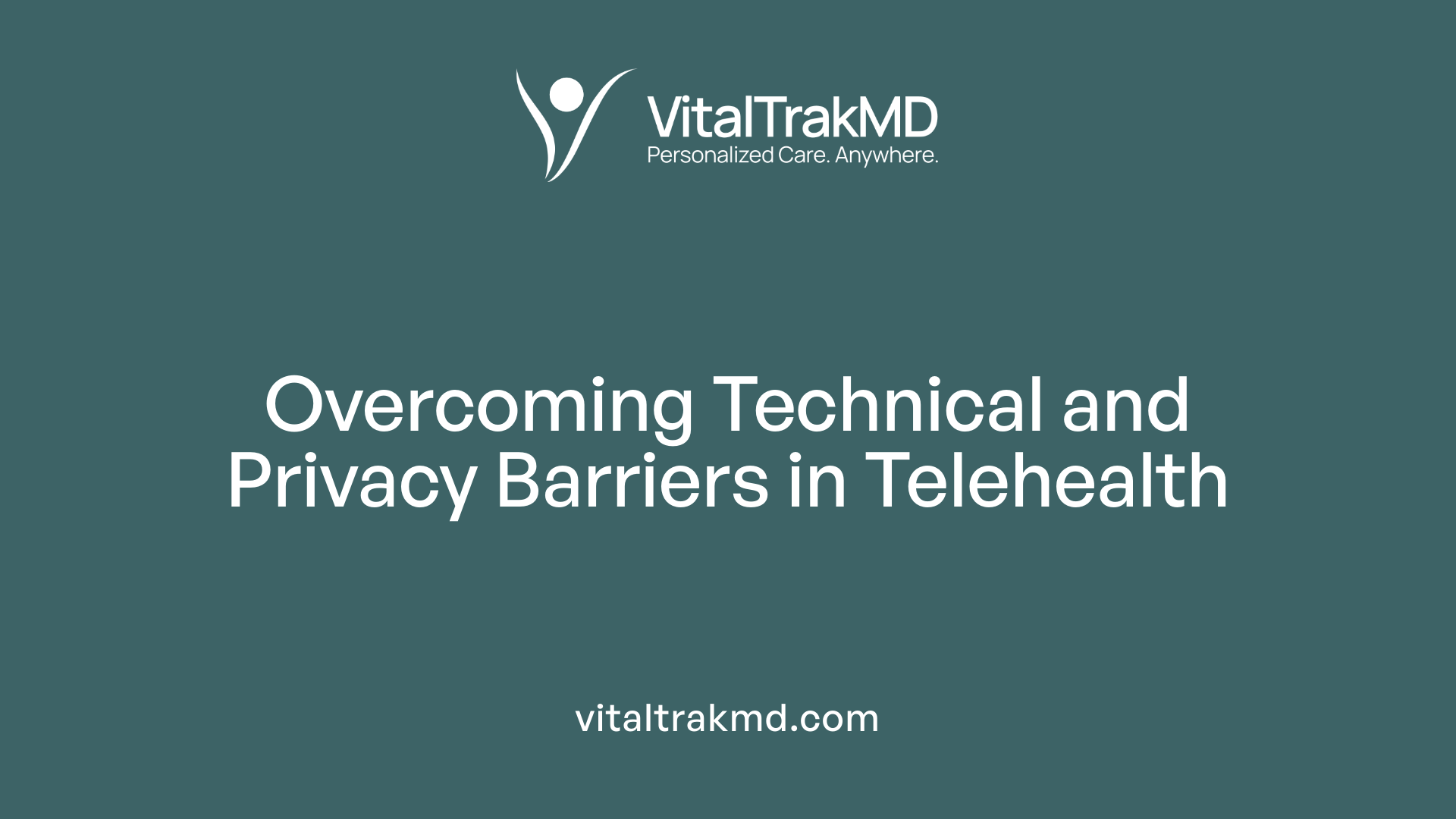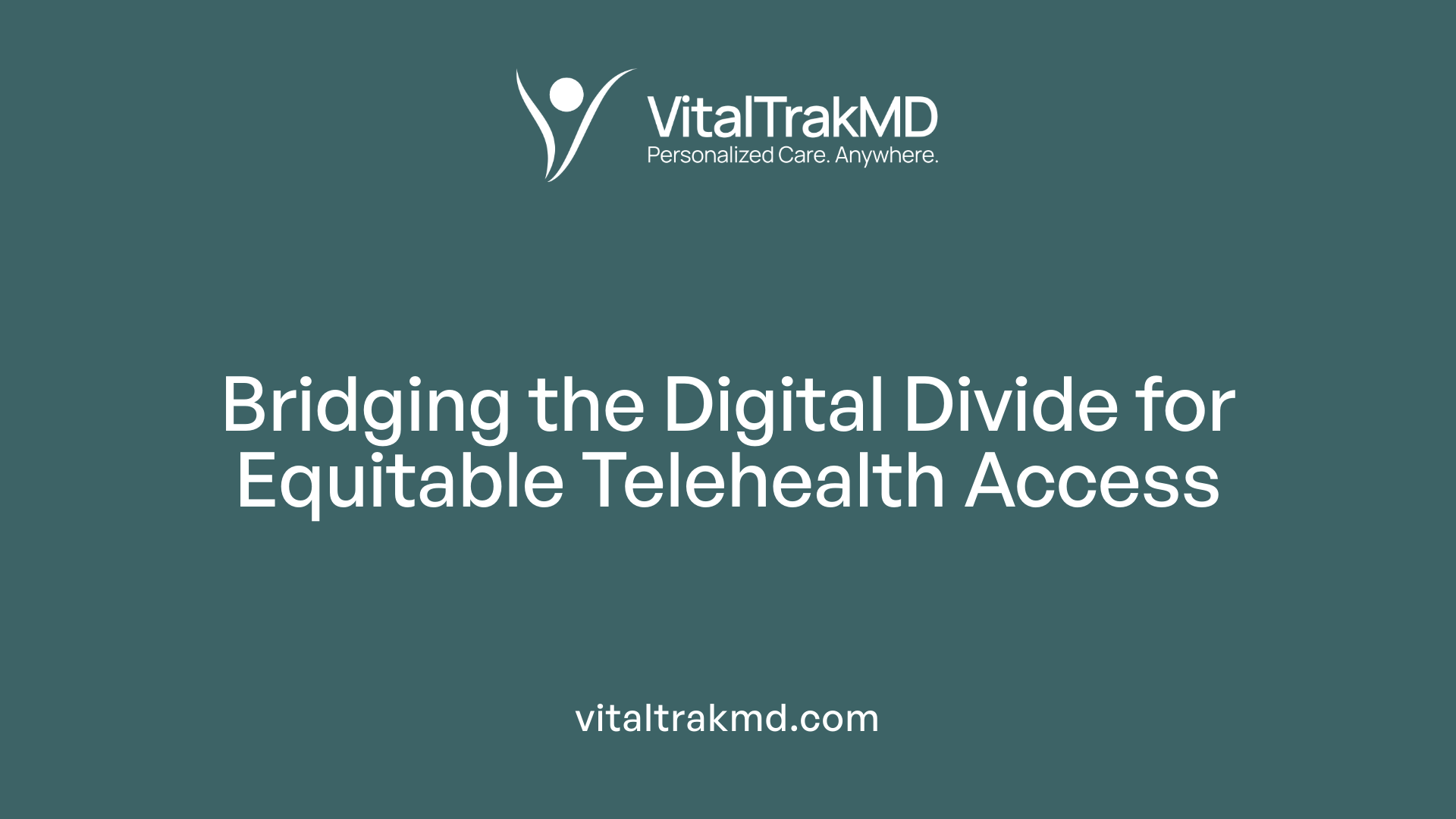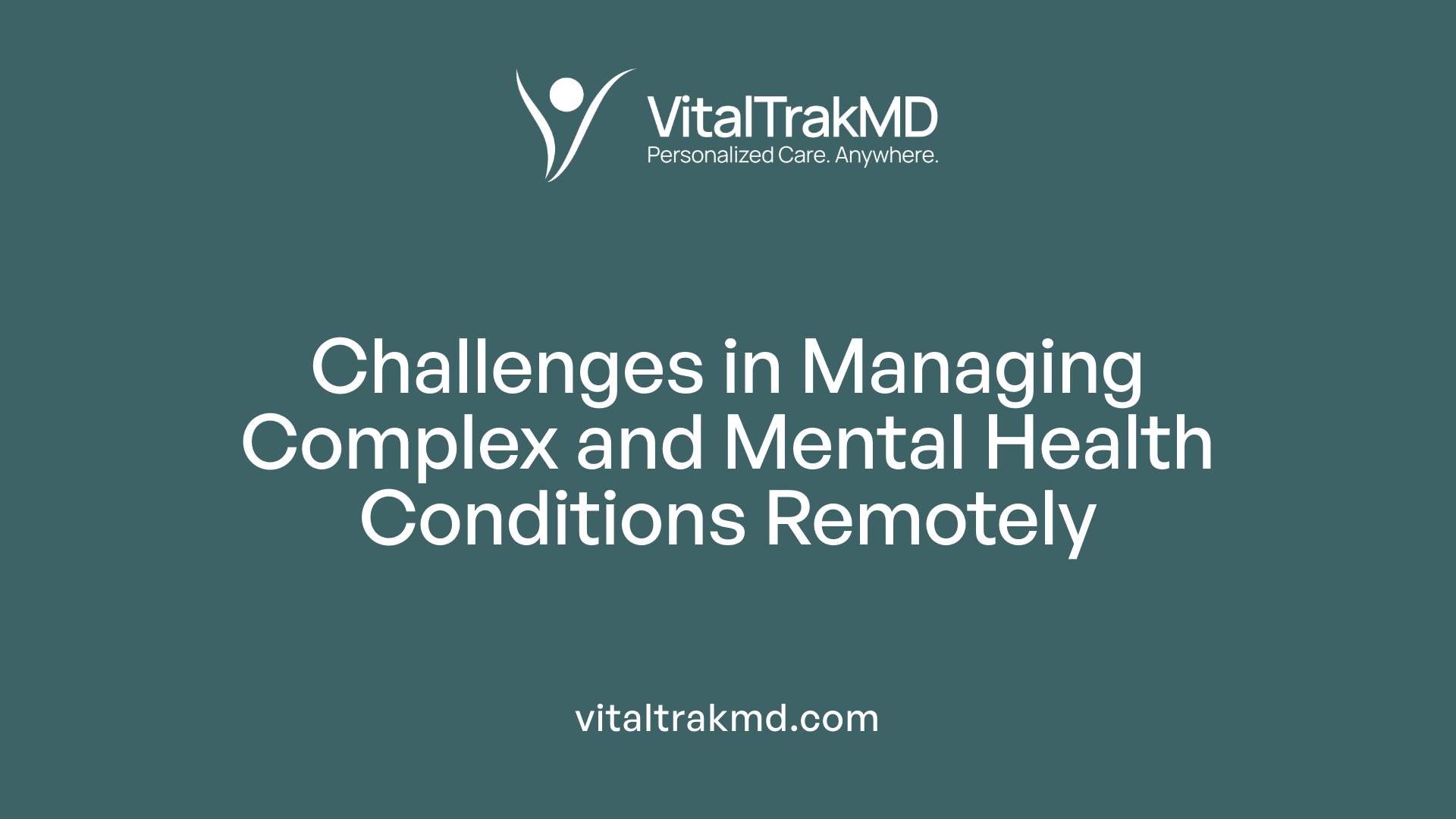Why Telemedicine Alone Falls Short in Delivering Personalized Healthcare

Understanding Telemedicine's Scope and Its Limitations
Telemedicine has revolutionized healthcare delivery by enhancing access, reducing geographical barriers, and supporting remote patient management. However, as promising as it is, relying solely on telehealth technologies falls short of delivering comprehensive and deeply personalized care. This article explores the multifaceted limitations of telemedicine, highlighting why integrating additional technological, systemic, and human elements is essential to achieving truly tailored healthcare solutions.
The Inadequacy of Telemedicine for Physical and Visual Assessments

What are the limitations of telemedicine in providing comprehensive and personalized healthcare?
Telemedicine has transformed healthcare by increasing access and offering convenience, but it faces notable limitations, especially regarding physical and visual assessments.
One of the primary challenges is the inability to perform hands-on physical examinations. For example, auscultation, which involves listening to heart and lung sounds, requires specialized equipment and direct contact, which virtual visits cannot accommodate. Similarly, palpation, used to evaluate swelling, tenderness, or abnormal masses, is impossible through a screen. These physical checks are often essential for accurate diagnosis.
Visual cues are another area where telehealth encounters limitations. Subtle signs such as skin discoloration, slight swelling, or fine movements can be difficult to detect with camera resolution or poor lighting. These nuances often assist healthcare providers in identifying and diagnosing conditions more precisely.
The impact of these limitations is significant. Without thorough physical exams and visual assessments, healthcare providers may have to rely heavily on patient-reported symptoms and limited visual information, which can lead to diagnostic inaccuracies. This situation could potentially result in misdiagnoses or delayed treatment.
Technical issues further complicate assessments. Poor internet connectivity, unstable platforms, or hardware inadequacies like low-quality cameras can reduce clarity and reliability during virtual evaluations. Privacy and security concerns also pose risks, especially over unsecured networks where sensitive health data could be vulnerable to breaches.
Regulatory policies and the digital divide add additional layers of difficulty. Patients in rural areas or older adults with limited digital literacy might find it harder to access or navigate telehealth services effectively. These barriers can restrict the scope of care and the potential for personalized health management.
In summary, while telemedicine greatly enhances healthcare accessibility, its inability to conduct comprehensive physical and visual examinations limits its effectiveness. For certain conditions, in-person visits remain vital to ensure accurate diagnoses, appropriate treatments, and truly personalized care.
| Limitation | Explanation | Consequence |
|---|---|---|
| Physical exmanations (auscultation, palpation) | Requires direct contact and specialized equipment | Missed signs, misdiagnosis |
| Visual cues | Subtle signs hard to detect remotely | Reduced diagnostic accuracy |
| Technical issues | Connectivity, hardware limitations | Poor communication, assessment errors |
| Privacy concerns | Data security risks | Patient trust, compliance |
| Access barriers | Digital literacy, infrastructure | Disparities in care |
Understanding these restrictions highlights the need for complementary strategies, including in-person assessments where necessary and technological innovations, to bridge these gaps and offer more comprehensive telehealth solutions.
Technical Challenges and Privacy Concerns Limiting Telehealth Efficacy

What are the limitations of telemedicine in providing comprehensive and personalized healthcare?
Telemedicine has opened new frontiers in healthcare delivery, offering convenience and improved access for many patients. However, it faces notable limitations in delivering truly comprehensive and personalized care.
One of the main challenges is the inability to conduct physical examinations. Health assessments often depend on tactile and visual cues, such as auscultation or palpation, which virtual platforms cannot replicate. This can lead to diagnostic uncertainties or the need for subsequent in-person visits.
Technological issues further complicate telehealth effectiveness. Connectivity problems, especially in rural or underserved areas, can disrupt consultations. Hardware limitations, like outdated devices or poor-quality cameras and microphones, hinder clear communication and visual assessment.
Platform malfunctions and software glitches are also prevalent barriers. These technical failures can cause delays, interrupted sessions, or loss of critical data, undermining the trust and reliability of telehealth services.
Privacy and data security remain pressing concerns. The transmission and storage of sensitive health information over digital networks introduce risks of breaches and hacking. Despite encryption and security protocols, cyber threats continue to pose vulnerabilities, especially over unsecured or public Wi-Fi networks.
In addition, regulatory and digital literacy barriers can restrict access. Older adults or individuals with limited internet access or digital skills may find telehealth intimidating or inaccessible, further exacerbating health disparities.
Overall, while telemedicine advances healthcare delivery, overcoming these technical and privacy barriers is essential to improve its quality, safety, and trustworthiness. Addressing infrastructure gaps, enhancing cybersecurity measures, and ensuring platform reliability are crucial steps for maximizing telehealth's potential.
The Digital Divide and Its Impact on Equity in Telehealth

What are the barriers faced by vulnerable populations, such as the elderly, low-income groups, and rural communities, in accessing telehealth services?
Vulnerable groups often encounter significant obstacles when attempting to access telehealth. Elderly individuals may struggle with digital literacy or be uncomfortable using new technologies. Low-income populations might lack access to high-speed internet or up-to-date devices necessary for remote healthcare. Rural communities frequently face connectivity issues due to inadequate broadband infrastructure, which hampers real-time communication with healthcare providers. These barriers reduce the ability of vulnerable populations to benefit fully from telehealth services, limiting their access to timely and necessary care.
How do digital literacy and internet access influence telehealth adoption?
Digital literacy—the skills required to navigate digital tools—is crucial for engaging with telehealth platforms effectively. Patients who lack familiarity with technology may experience frustration or fear, leading to lower engagement. Simultaneously, reliable internet access is fundamental for video consultations, data sharing, and continuous monitoring. Without stable internet, patients cannot participate in virtual visits or utilize remote monitoring devices. These factors collectively determine whether patients can adopt telehealth, and gaps in digital literacy or internet availability can deepen health inequities.
What are the risks of widening health disparities if access challenges remain unaddressed?
If existing access issues are not tackled, telehealth could inadvertently exacerbate disparities in healthcare. Vulnerable populations may remain underserved or be further marginalized as they cannot utilize digital health tools effectively. This digital divide prevents equitable care delivery, potentially leading to worse health outcomes among disadvantaged groups. To mitigate this, tailored policies and digital solutions that account for diverse needs are essential. Ensuring everyone has suitable devices, affordable internet, and digital literacy support is vital to realizing telehealth's promise of improved health equity.
Limitations in Mental Health and Complex Medical Condition Management

What are the limitations of telemedicine in mental health treatments and managing complex medical services?
Telehealth has brought many benefits to healthcare, including increased access and convenience. However, when it comes to mental health and complex medical conditions, several challenges emerge.
Establishing a strong therapeutic relationship remotely can be difficult. Non-verbal cues like body language and subtle facial expressions are harder to interpret through screens, which can impact rapport and trust between patients and providers.
Technical barriers also affect access, especially for vulnerable groups. Elderly patients, those with low digital literacy, or individuals lacking reliable internet or modern devices may find it hard to engage fully with remote services.
Privacy concerns pose another obstacle. Patients seeking mental health treatment might struggle to find a private, quiet space at home to speak openly, affecting the honesty and effectiveness of therapy sessions.
Managing severe or complex health issues remotely is limited. Physical examinations, such as auscultation or palpation, cannot be performed virtually. This can lead to missed diagnoses or inadequate management of conditions requiring close monitoring.
Additionally, technical issues like connectivity problems, insufficient provider training, and regulatory constraints can hinder seamless care delivery. These factors combined mean that telehealth, while valuable, cannot fully replace in-person interactions for all aspects of mental health and complex medical care.
To maximize benefits, healthcare systems must address these limitations with targeted solutions, ensuring vulnerable populations are not left behind and that care quality remains high.
The Necessity of Systematic Integration for Better Outcomes
How does integrating telemedicine with other healthcare strategies improve patient outcomes?
Integrating telemedicine with broader healthcare strategies significantly boosts patient care quality and outcomes. When telehealth services are combined with data-driven tools, team collaboration, and patient engagement initiatives, the results are powerful. This approach helps increase access to care for underserved populations, including those in rural or remote areas.
By enabling timely diagnosis and ongoing management of chronic illnesses like diabetes and heart disease, integrated telehealth ensures continuous monitoring and support. It also streamlines care coordination among different healthcare providers, fostering more personalized treatment plans. This seamless communication reduces hospital visits, minimizes fragmented care, and improves overall health metrics.
Moreover, embedding telemedicine into existing health systems enhances safety, compliance, and operational efficiency. It empowers providers with better information, supports interdisciplinary teamwork, and engages patients more actively in their health.
In essence, structured integration transforms telehealth from a standalone service into a vital component of comprehensive healthcare. This strategic approach creates a more accessible, connected, and effective care environment that benefits patients and providers alike.
The Limitations of Telemedicine in Addressing Complex and Time-Sensitive Needs

Why can't telemedicine alone meet all healthcare needs for personalized patient care?
While telemedicine has transformed healthcare delivery by increasing access and improving efficiency, it faces limitations when it comes to managing complex and urgent health needs.
One major challenge is the inability to perform hands-on procedures or immediate interventions. Physical examinations such as auscultation, palpation, or administering injections cannot be done remotely, which can hinder accurate diagnosis and timely treatment.
This limitation is particularly critical for severe or urgent health conditions that require rapid, in-person assessment and intervention. For example, acute chest pain, trauma, or sudden neurological symptoms often necessitate immediate physical evaluation and potentially lifesaving procedures.
Additionally, telemedicine heavily relies on patient self-reporting and remote data collection. While wearable devices and clinical apps provide valuable information, there is often a delay in data transmission or gaps due to technical issues. This can lead to incomplete picture of the patient's condition, making real-time, comprehensive assessment difficult.
Vulnerable populations such as the elderly, those with limited digital literacy, or individuals in remote areas may face further barriers. Limited access to reliable internet, privacy concerns, or inability to operate digital tools can compromise care quality.
Furthermore, telemedicine encounters are often limited by regulatory restrictions, variable licensing laws across regions, and reimbursement policies, which can restrict its scope and availability.
Considering these factors, telemedicine functions best as a supplement to in-person care rather than a replacement, especially for complex or time-sensitive health situations that demand hands-on procedures and immediate action.
The Complementary Role of Advanced Technologies in Personalization
How does combining telehealth with other technological and human elements improve personalized healthcare?
Integrating telehealth with cutting-edge technologies such as artificial intelligence (AI), remote monitoring devices, and digital health tools greatly improves the personalization of healthcare services.
AI can analyze vast amounts of health data to help identify patterns that support early disease detection and provide targeted treatment recommendations. For instance, AI models can review medical images or patient data to assist in diagnosing conditions promptly.
Remote health monitoring devices like wearables continuously collect vital health metrics—such as blood pressure, glucose levels, and heart rate—in real time. This ongoing data stream allows healthcare providers to closely track patients' health outside of clinical settings, enabling proactive and tailored interventions.
Digital health tools, including patient portals and secure messaging platforms, facilitate constant communication between patients and providers. These tools help patients stay engaged with their care plans and receive personalized guidance based on their evolving health data.
By blending technology with human clinical judgment, healthcare teams can craft more precise and adaptable care plans. For example, a provider can combine insights from telehealth consultations, digital data, and patient history to optimize treatments.
Furthermore, telehealth enhances collaboration among healthcare providers. Specialist input via virtual consults ensures patients receive comprehensive care tailored to their individual needs.
This synergy creates a healthcare environment where services are not only more accessible but also more aligned with each patient’s specific health profile, leading to better outcomes and higher satisfaction.
In summary, merging telehealth with AI, remote monitoring, and digital tools fosters continuous, personalized care—making healthcare more effective, inclusive, and responsive to individual needs.
Harnessing AI to Overcome Telemedicine’s Shortcomings
How can additional technologies like AI help address telemedicine's shortcomings and facilitate tailored patient care?
Artificial Intelligence (AI) plays a vital role in enhancing telehealth services by making care delivery more precise and patient-centered. It supports remote assessments by analyzing vast amounts of data from wearables, clinical devices, and health records, enabling more accurate diagnostics without physical exams.
AI-powered tools like image recognition can detect early signs of diseases, while natural language processing allows virtual assistants to understand and respond to patient inquiries. These advances streamline workflows for providers, freeing them to focus on complex decision-making.
Continuous monitoring of chronic conditions becomes more effective with AI-enabled remote tracking, which detects subtle changes in health indicators. This proactive approach prompts timely interventions, potentially reducing hospital admissions and improving long-term outcomes.
Supportive features such as virtual health assistants and chatbots improve patient engagement by providing 24/7 support, medication reminders, and health education. These tools make healthcare more accessible, especially for vulnerable populations with limited access to in-person care.
Despite these improvements, challenges remain. Addressing ethical issues, privacy concerns, and algorithm biases is crucial to deploying AI responsibly. Ensuring that AI systems are transparent, fair, and validated can help build trust and promote equitable health outcomes.
In sum, AI enhances telemedicine by enabling tailored, proactive care while raising important considerations for safe and ethical use.
The Way Forward: Holistic Care with Human and Technological Synergy
Why telemedicine alone falls short in delivering personalized healthcare?
Telemedicine has revolutionized access to healthcare, offering convenient remote consultations and continuous monitoring. However, it cannot fully replace in-person visits when it comes to personalized patient care. Physical examinations such as auscultation, palpation, and direct assessment are vital for accurate diagnosis—things that virtual platforms often cannot replicate.
Besides diagnostic limitations, telehealth faces hurdles related to privacy, data security, and technical issues like connectivity disruptions. Regulatory hurdles like licensing variances across regions and reimbursement policies further complicate its widespread adoption. Many patients, especially older adults or those with limited access to digital devices, experience barriers like low digital literacy or poor internet connectivity, limiting equitable access.
Thus, telemedicine works best as a supportive tool rather than a standalone solution. It complements in-person evaluations for ongoing management, especially for complex or urgent health issues. Integrating telehealth with hands-on care ensures that patient safety, personalized assessments, and trust are maintained.
How can adapting care models improve integration with in-person and social support?
A comprehensive approach to healthcare involves not only digital tools but also community and social services. Combining telehealth with tailored self-help interventions, community support programs, and in-person visits can bridge gaps in care. For example, in vulnerable populations such as the elderly or socioeconomically disadvantaged, in-home visits or assistance from social workers can address social determinants like housing, food security, and social connectivity.
This integration helps optimize health outcomes by providing holistic support that considers social factors influencing health. For example, addressing issues like low health literacy or unstable housing can significantly improve engagement and adherence to treatment plans.
What policy and systemic reforms are necessary for equitable access?
To ensure telehealth benefits all, systemic reforms are essential. Policymakers should focus on expanding broadband infrastructure, especially in rural and underserved areas, to close the digital divide.
Revisions in licensing and reimbursement policies can facilitate cross-region service delivery and encourage providers to invest in telehealth infrastructure. Additionally, implementing standards for data privacy and security builds patient trust.
Targeted programs are needed to support vulnerable groups—such as providing digital literacy training or offering devices and internet subsidies. Policies that promote collaboration between healthcare providers, social services, and community organizations will foster a more inclusive care ecosystem.
By combining technological advances with systemic support, health systems can deliver equitable, personalized, and holistic care that adapts to diverse patient needs.
| Aspect | Challenges | Solutions | Impact |
|---|---|---|---|
| Accessibility | Digital divide, low digital literacy | Broadband expansion, digital literacy programs | Increased reach to vulnerable populations |
| Integration | Fragmented care, lack of holistic tools | Care coordination, community involvement | Better health outcomes and patient satisfaction |
| Personalization | Data security, algorithm bias | Robust regulation, ethical AI use | Reliable, fair, and effective care |
| Policy | Licensing, reimbursement barriers | Policy reform, cross-state agreements | Broader, equitable telehealth deployment |
Integrating Human Touch and Technology for True Personalization
While telemedicine has significantly expanded healthcare access and improved certain outcomes, its standalone application cannot deliver the comprehensive, compassionate, and highly personalized care that patients need. Overcoming its limitations requires a concerted effort to embed telehealth within integrated healthcare systems that combine technological innovations like AI and digital monitoring with human judgment, relational skills, and systemic reforms. Only through such holistic approaches can healthcare providers truly meet the complex, emotionally nuanced, and individual needs of each patient, ensuring equitable, effective, and patient-centered care in the digital age.
References
- Why “Telehealth” Alone Isn't Enough | Mozzaz
- Beyond Technology: The Human Element in Healthcare ...
- Why traditional telehealth falls short–and how Sana Care ...
- The tragic paradoxical effect of telemedicine on healthcare ...
- Healthcare & Tech: Telemedicine, Personalised & Digital ...
- Artificial intelligence in healthcare delivery: Prospects and ...
- Telemedicine in Healthcare: Benefits, Challenges, and ...
- The Benefits and Limitations of Telehealth
Recent articles
Want to Feel Better and Live Healthier?
Join hundreds of patients taking control of their health with personalized care that fits their life – not the other way around.
Rated 4.8/5 by 32+ customers







